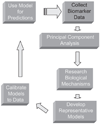Translational systems approaches to the biology of inflammation and healing
- PMID: 20170421
- PMCID: PMC3134151
- DOI: 10.3109/08923970903369867
Translational systems approaches to the biology of inflammation and healing
Abstract
Inflammation is a complex, non-linear process central to many of the diseases that affect both developed and emerging nations. A systems-based understanding of inflammation, coupled to translational applications, is therefore necessary for efficient development of drugs and devices, for streamlining analyses at the level of populations, and for the implementation of personalized medicine. We have carried out an iterative and ongoing program of literature analysis, generation of prospective data, data analysis, and computational modeling in various experimental and clinical inflammatory disease settings. These simulations have been used to gain basic insights into the inflammatory response under baseline, gene-knockout, and drug-treated experimental animals for in silico studies associated with the clinical settings of sepsis, trauma, acute liver failure, and wound healing to create patient-specific simulations in polytrauma, traumatic brain injury, and vocal fold inflammation; and to gain insight into host-pathogen interactions in malaria, necrotizing enterocolitis, and sepsis. These simulations have converged with other systems biology approaches (e.g., functional genomics) to aid in the design of new drugs or devices geared towards modulating inflammation. Since they include both circulating and tissue-level inflammatory mediators, these simulations transcend typical cytokine networks by associating inflammatory processes with tissue/organ impacts via tissue damage/dysfunction. This framework has now allowed us to suggest how to modulate acute inflammation in a rational, individually optimized fashion. This plethora of computational and intertwined experimental/engineering approaches is the cornerstone of Translational Systems Biology approaches for inflammatory diseases.
Conflict of interest statement
Figures



Similar articles
-
Translational systems biology of inflammation and healing.Wound Repair Regen. 2010 Jan-Feb;18(1):3-7. doi: 10.1111/j.1524-475X.2009.00566.x. Wound Repair Regen. 2010. PMID: 20082674 Free PMC article.
-
Translational systems biology of inflammation: potential applications to personalized medicine.Per Med. 2010 Sep 1;7(5):549-559. doi: 10.2217/pme.10.45. Per Med. 2010. PMID: 21339856 Free PMC article.
-
Folic acid supplementation and malaria susceptibility and severity among people taking antifolate antimalarial drugs in endemic areas.Cochrane Database Syst Rev. 2022 Feb 1;2(2022):CD014217. doi: 10.1002/14651858.CD014217. Cochrane Database Syst Rev. 2022. PMID: 36321557 Free PMC article.
-
Systems biology and inflammation.Methods Mol Biol. 2010;662:181-201. doi: 10.1007/978-1-60761-800-3_9. Methods Mol Biol. 2010. PMID: 20824472
-
Translational systems biology of inflammation.PLoS Comput Biol. 2008 Apr 25;4(4):e1000014. doi: 10.1371/journal.pcbi.1000014. PLoS Comput Biol. 2008. PMID: 18437239 Free PMC article. Review.
Cited by
-
Sepsis: from pattern to mechanism and back.Crit Rev Biomed Eng. 2012;40(4):341-51. doi: 10.1615/critrevbiomedeng.v40.i4.80. Crit Rev Biomed Eng. 2012. PMID: 23140124 Free PMC article. Review.
-
Towards a Physiological Scale of Vocal Fold Agent-Based Models of Surgical Injury and Repair: Sensitivity Analysis, Calibration and Verification.Appl Sci (Basel). 2019 Aug 1;9(15):2974. doi: 10.3390/app9152974. Epub 2019 Jul 25. Appl Sci (Basel). 2019. PMID: 31372307 Free PMC article.
-
From data patterns to mechanistic models in acute critical illness.J Crit Care. 2014 Aug;29(4):604-10. doi: 10.1016/j.jcrc.2014.03.018. Epub 2014 Mar 29. J Crit Care. 2014. PMID: 24768566 Free PMC article. Review.
-
Insights into the Role of Chemokines, Damage-Associated Molecular Patterns, and Lymphocyte-Derived Mediators from Computational Models of Trauma-Induced Inflammation.Antioxid Redox Signal. 2015 Dec 10;23(17):1370-87. doi: 10.1089/ars.2015.6398. Antioxid Redox Signal. 2015. PMID: 26560096 Free PMC article. Review.
-
In Silico Augmentation of the Drug Development Pipeline: Examples from the study of Acute Inflammation.Drug Dev Res. 2011 Mar 1;72(2):187-200. doi: 10.1002/ddr.20415. Drug Dev Res. 2011. PMID: 21552346 Free PMC article.
References
-
- Brown KL, Cosseau C, Gardy JL, Hancock RE. Complexities of targeting innate immunity to treat infection. Trends Immunol. 2007;28:260–266. - PubMed
-
- Medzhitov R. Origin and physiological roles of inflammation. Nature. 2008;454:428–435. - PubMed
-
- Nathan C. Points of control in inflammation. Nature. 2002;420:846–852. - PubMed
Publication types
MeSH terms
Substances
Grants and funding
- R01 AI080799/AI/NIAID NIH HHS/United States
- R01 HL080926/HL/NHLBI NIH HHS/United States
- R01-AI080799/AI/NIAID NIH HHS/United States
- P50-GM-53789/GM/NIGMS NIH HHS/United States
- R01-HL-76157/HL/NHLBI NIH HHS/United States
- R01-GM-67240/GM/NIGMS NIH HHS/United States
- R33 HL089082/HL/NHLBI NIH HHS/United States
- U01-DK072146-05/DK/NIDDK NIH HHS/United States
- R01 HL076157/HL/NHLBI NIH HHS/United States
- R01 DC008290/DC/NIDCD NIH HHS/United States
- R33-HL-089082/HL/NHLBI NIH HHS/United States
- P50 GM053789/GM/NIGMS NIH HHS/United States
- R01 GM067240/GM/NIGMS NIH HHS/United States
- R01-HL080926/HL/NHLBI NIH HHS/United States
- U01 DK072146/DK/NIDDK NIH HHS/United States
LinkOut - more resources
Full Text Sources
